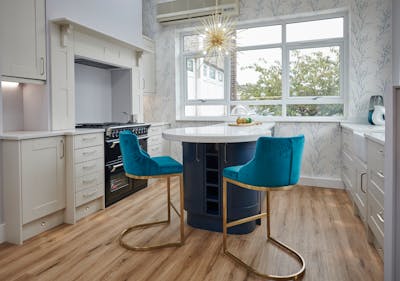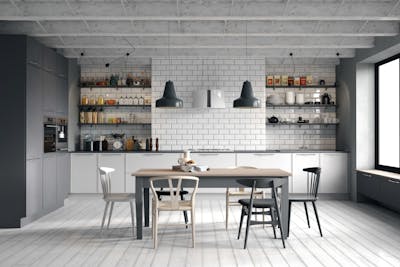How To Design A Kitchen Island | More Kitchens
Published: 18 March 2021 · Last Updated: 30 October 2023
The kitchen island - a hub teeming with lively conversations, family gatherings, memorable celebrations, and culinary artistry - holds a special place in the heart of any home.
The benefits of having a kitchen island are considerable. Not only is it a super practical place in terms of the storage you can use, but it can also become a space of connection with your family and friends whilst cooking at the same time.
If you’re thinking about getting a kitchen island in your home, here is everything you need to know about designing it.
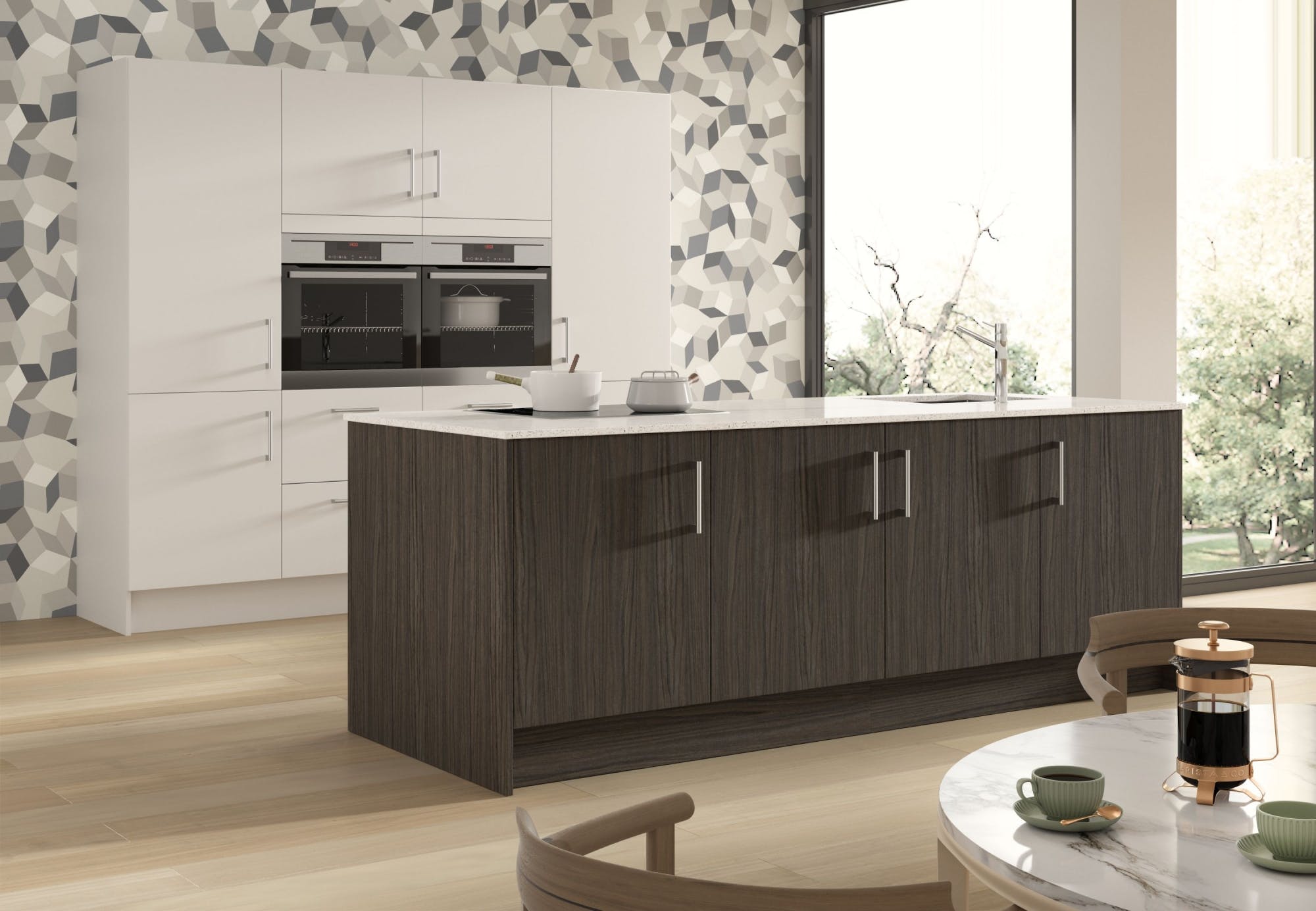
What is a kitchen island?
There are many different types of kitchen islands, each with its own unique benefits and drawbacks. Some of the most common types include:
> Freestanding islands: These islands are not attached to any other cabinets or countertops, and they can be placed anywhere in the kitchen. They offer the most flexibility in terms of size and shape, but they can also be more difficult to install.
> Peninsula islands: These islands are attached to one wall, but they extend into the kitchen. They offer a good compromise between flexibility and space, and they can be a good option for small kitchens.
> Semi-flush islands: These islands are partially attached to the countertop, and they create a seamless look. They are a good option for kitchens with limited space, but they can be more difficult to customise.
> Built-in islands: These islands are built into the kitchen and cannot be moved. They offer the most storage space, but they are also the most permanent option.
Positioned strategically at the core of your culinary space, it embodies a myriad of functions and advantages. From having an enhanced working space for meal preparation, chopping and cooking to having a great storage area to fit in all of your pots and pans, spices and teas, the kitchen island is much more than a simple item of furniture.
The benefits of having a kitchen island
More workspace
In the heart of a bustling kitchen, workspace is paramount. A kitchen island provides an expansive, dedicated area for various culinary tasks. Whether you're chopping vegetables, kneading dough for your family’s favourite pizza, or assembling ingredients for a gourmet feast, the island's ample surface allows you to spread out and work with ease.
This extra workspace proves particularly advantageous during busy cooking sessions or when multiple chefs collaborate in the kitchen. The island becomes your culinary canvas, enhancing your efficiency and creativity.
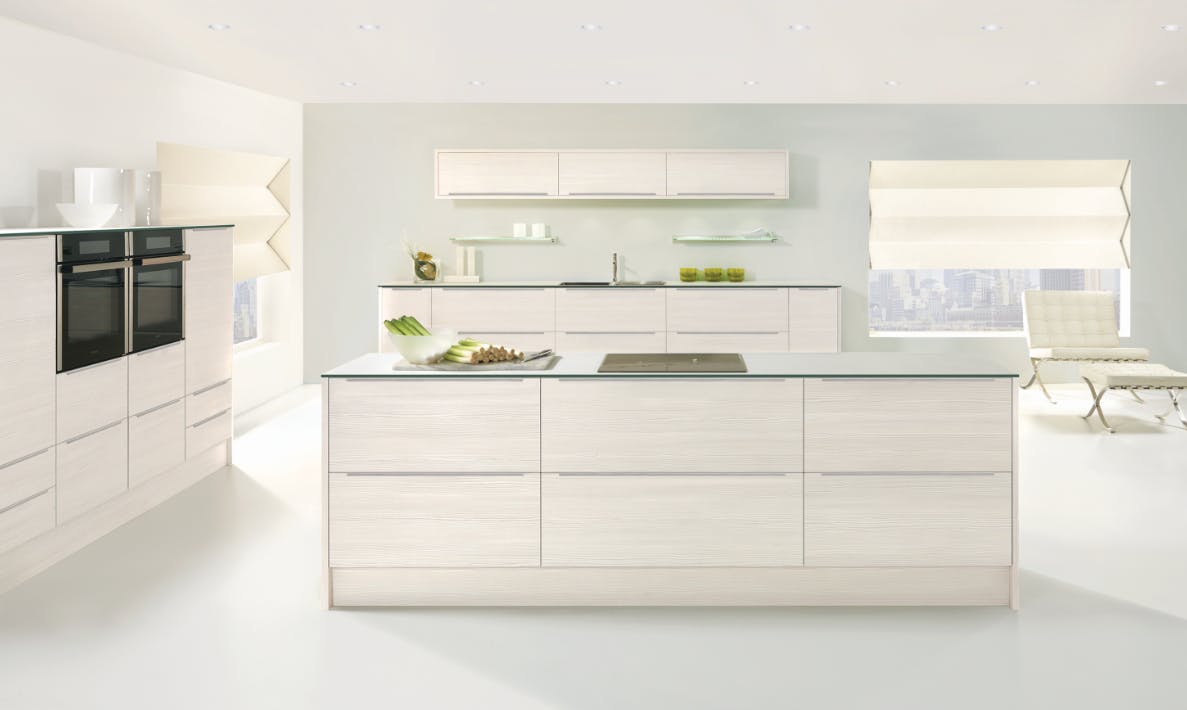
More storage
The battle against kitchen clutter is a daily challenge. Here, the kitchen island emerges as a formidable ally.
Beneath its elegant exterior lies a treasure trove of storage opportunities. Cabinets, drawers, and shelves ingeniously integrated into the island provide homes for pots, pans, utensils, dishes, and an array of kitchen essentials.
This organisation not only streamlines your cooking process but also ensures that every item has its designated place, making it easily accessible. A well-organised kitchen not only looks elegant but functions effortlessly, saving you precious time and effort.
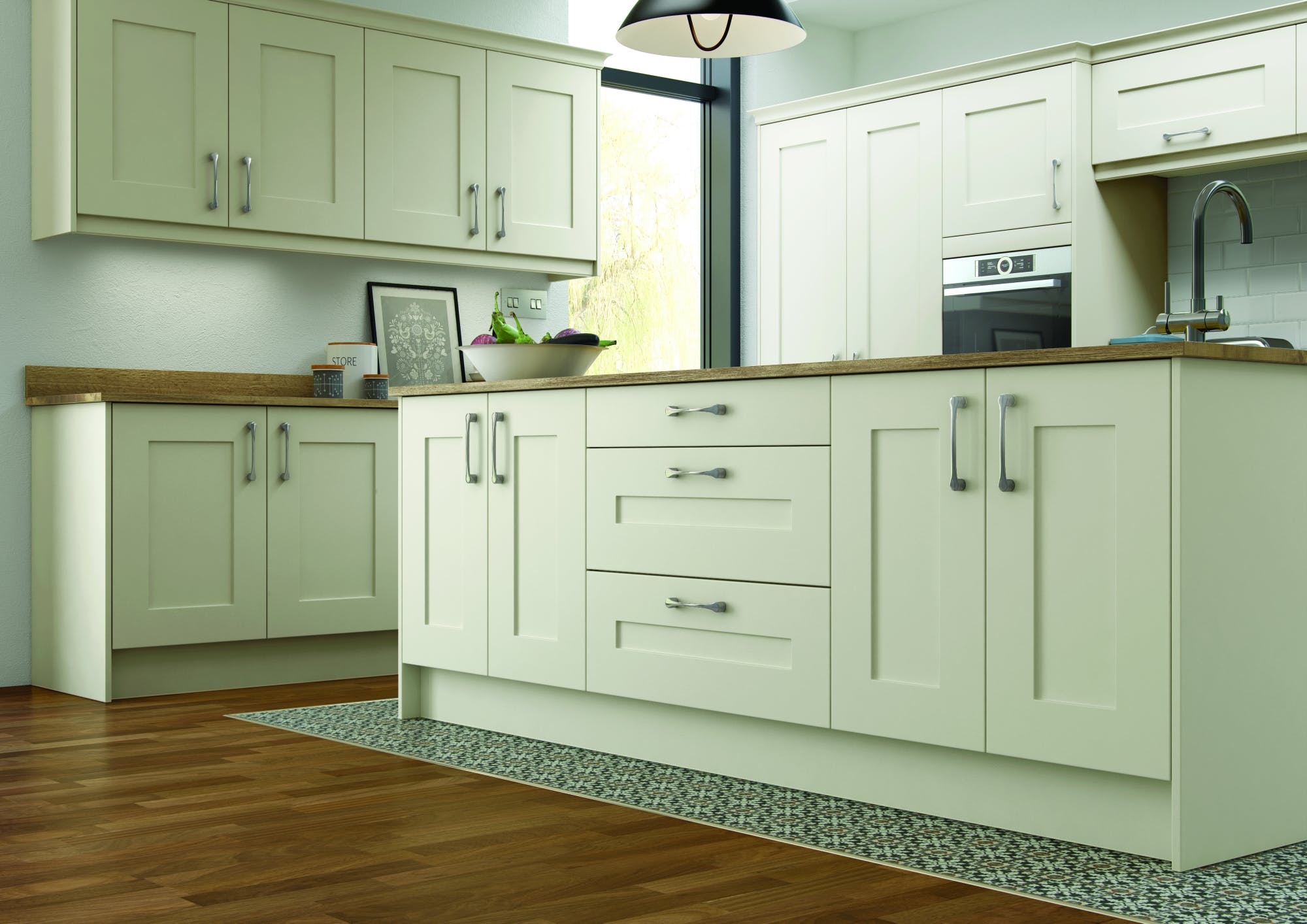
More seating
In today's dynamic kitchens, cooking is no longer a solitary pursuit but a communal experience.
A kitchen island with built-in seating options transforms the cooking space into a social hub. It invites family members and guests to sit, chat, or lend a helping hand while you prepare meals.
Whether it's a quick breakfast with your loved ones or an informal gathering during dinner preparations, the island fosters connections and creates cherished moments. It blurs the line between chef and audience, making your kitchen the heart of your home.
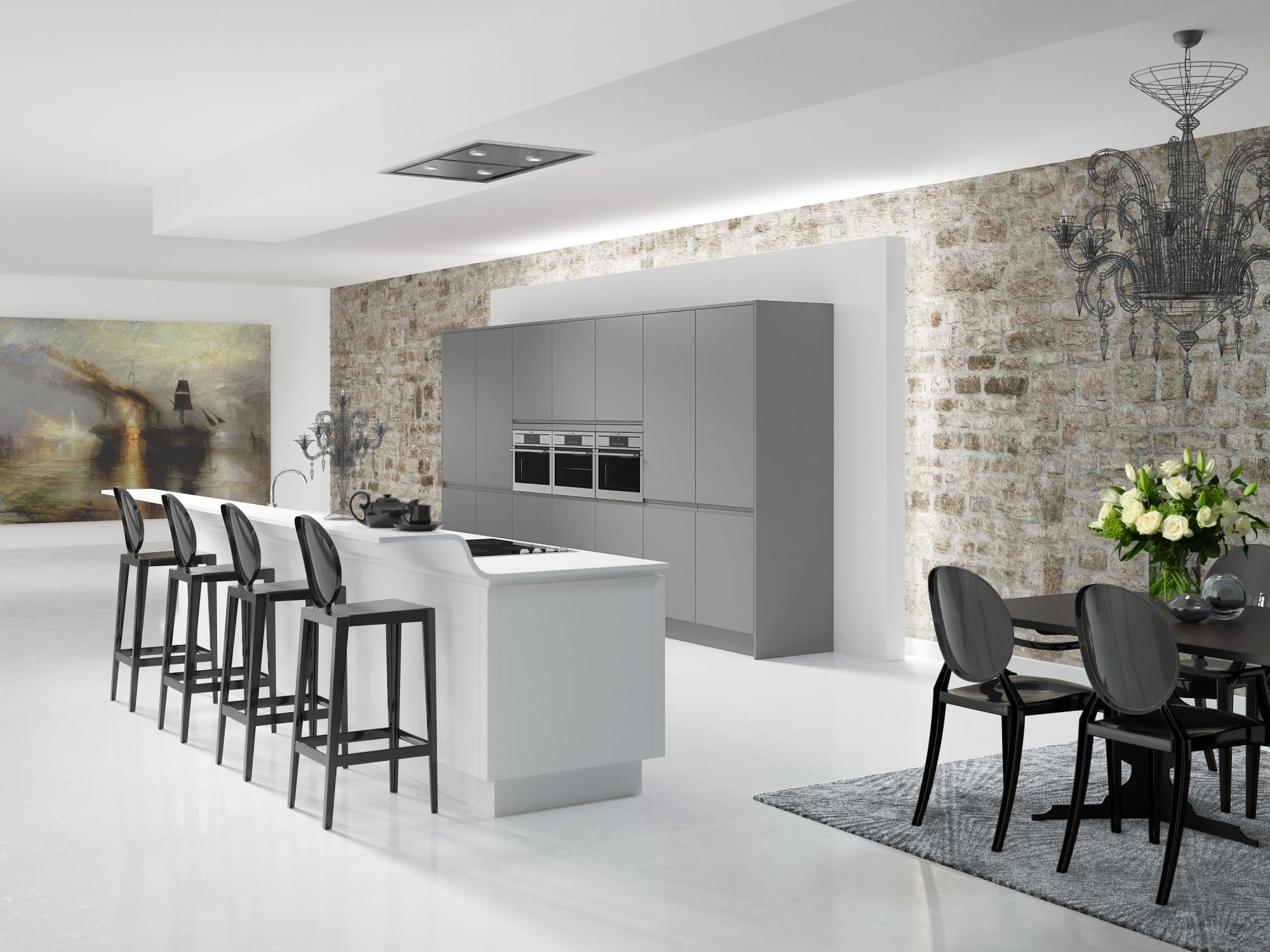
When is a kitchen island not a good idea?
Even though kitchen islands are versatile and advantageous in many situations, there are scenarios where their inclusion may not be the most practical choice. Let's explore two key considerations:
Small kitchens
In compact kitchens, the inclusion of a kitchen island can present a significant challenge - making your workspace feel very cramped.
The limited floor space may make it challenging to introduce an island without compromising the overall flow and functionality of the room. In such cases, the island can indeed make the space feel cramped, inhibiting movement and accessibility.
The key here is thoughtful design that maximises every available surface. Opting for a smaller, streamlined island or exploring alternative space-saving solutions, like a peninsula, may be more appropriate for petite kitchens. This ensures that your kitchen remains efficient and uncluttered, even in cosy situations.
.jpg?auto=compress%2Cformat&cs=strip&ixlib=php-1.1.0&s=5dd50ad091853180ea8122cfef81c5a1)
Limited counter space
Kitchens with existing limitations in counter space must exercise caution when contemplating a kitchen island.
The addition of an island, no matter how aesthetically appealing, can exacerbate the issue by further reducing the amount of available workspace. For kitchens where counter space is already at a premium, the island may not provide the anticipated benefits and could potentially hinder meal preparation and everyday tasks.
In such cases, optimising the available counter space by utilising wall-mounted shelves, compact storage solutions, or fold-down counters can be a more prudent approach. This ensures that your kitchen remains functional and efficient, even in confined areas.
.jpg?auto=compress%2Cformat&cs=strip&ixlib=php-1.1.0&s=ac7426beeecf93754405996e88b3eded)
Planning your kitchen island
Size and shape
When it comes to your kitchen island, sizing and shape should match your kitchen's layout and your specific needs. To ensure ample space for movement, a good rule of thumb is to have around 90 centimetres or 36 inches of clearance on all sides of the island. This helps everyone navigate comfortably, especially in busy kitchen areas where congestion can be a hassle.
The shape of your kitchen island can also affect its functionality. If you love cooking and need a generous prep area, a square or rectangular island provides a spacious workspace. It's perfect for those who enjoy having plenty of room to create culinary masterpieces.
On the other hand, if you want a spot for family and friends to sit and chat while you cook, an L-shaped island offers both workspace and seating. Choose the shape that suits your cooking style and the overall flow of your kitchen.
.jpg?auto=compress%2Cformat&cs=strip&ixlib=php-1.1.0&s=a8e0030a6766994d61aa1d69e21c3884)
Location
The placement of your kitchen island is a pivotal design decision. It should harmonise with the flow of your kitchen, making it not just a functional feature but also a central hub for daily activities.
When space is at a premium, creativity becomes the key. You may want to consider placing your kitchen island in a corner to open up the centre of your kitchen while still offering the benefits of an island. This clever placement can also create a cosy and intimate atmosphere for dining and socialising.
Don't forget to take advantage of natural lighting. Placing your kitchen island near a window or under a skylight can provide a well-lit and inviting workspace. It also creates a pleasant atmosphere for dining.
.jpg?auto=compress%2Cformat&cs=strip&ixlib=php-1.1.0&s=0bf22ff7a62f6e04bb8c7bf5a2658379)
Materials
The materials you choose for your kitchen island will depend on your budget and style preferences. Popular materials for kitchen islands include wood, stone, and quartz.
The choice of countertop material for your kitchen island can significantly influence its appearance and functionality. Quartz countertops, for instance, are known for their durability and versatility. They come in various colours and patterns, offering a sleek and modern appearance while being resistant to stains and scratches.
Granite countertops, on the other hand, exude natural beauty and luxury. They come in a variety of colours and unique patterns, ensuring each island is distinctive.
The material you choose for your kitchen island will depend on your budget, style preferences, and durability needs. Some of the most popular materials include:
>Wood: Wood is a classic and natural material that can add warmth and character to a kitchen. It is also relatively affordable.
>Stone: Stone is a durable and long-lasting material that is resistant to stains and scratches. It is also a good choice for kitchens with high traffic.
>Quartz: Quartz is a man-made material that is made from natural quartz and resin. It is a good choice for kitchens with high traffic because it is stain-resistant and easy to clean.
>Laminate: Laminate is a low-cost material that is easy to care for. It is a good choice for kitchens on a budget.
>Concrete: Concrete is a durable and long-lasting material that can add a modern touch to a kitchen. It is a good choice for kitchens with a minimalist style.
.jpg?auto=compress%2Cformat&cs=strip&ixlib=php-1.1.0&s=6335afe89ee29331f4491ba1e310ba3d)
Sink and appliances
If you plan to include a sink and appliances on your kitchen island, you will need to make sure that they are properly installed and that there is enough space for them. Here’s how you can do that:
When incorporating a sink, ensure that it's properly installed, taking into account plumbing and drainage considerations. Position it in a way that allows for easy access and efficient workflow.
A well-designed island sink can make tasks like food preparation, dishwashing, and even serving meals more convenient.
When considering appliances like dishwashers, cooktops, or ovens, consult with a professional kitchen designer or contractor to ensure that the island can accommodate these elements seamlessly. Proper ventilation and electrical connections should also be factored in.
The goal is to make your island a versatile cooking and cleaning station while maintaining a harmonious design.
.jpg?auto=compress%2Cformat&cs=strip&ixlib=php-1.1.0&s=ea1067406123375e42a6da44dda2ffc2)
Storage
We all love a good storage space.
Adding a kitchen island with cabinets, drawers, or shelves is like giving your kitchen a storage boost. You can stash away things like pots, pans, utensils, small appliances, dishes, and pantry items in there. It's a nifty way to keep your kitchen neat and tidy by reducing the mess and clutter in other parts of the kitchen.
Kitchen islands with storage can also be helpful when entertaining guests. You can store extra serving dishes, glassware, or drinks on the island, making it easier to host gatherings and socialise with friends and family.
.jpg?auto=compress%2Cformat&cs=strip&ixlib=php-1.1.0&s=96d9d3cdd039d5f2e47e3e46f8f9e34d)
Seating
When planning seating for your kitchen island, comfort and aesthetics should go hand in hand. The choice of chairs or stools is not just about functionality and comfort, but also about enhancing the overall look of your kitchen.
Opt for seating that complements the style of your kitchen. If you have a modern kitchen, sleek and minimalist bar stools may be a perfect match. For a more traditional kitchen, consider chairs with classic design elements that blend seamlessly. Additionally, comfort is paramount, especially if your island serves as a gathering spot. Ergonomic considerations like backrests and cushioning should be evaluated.
You should also consider the kitchen work triangle as best practice for dimensions and size requirements when integrating an informal, breakfast bar type set up.
Kitchen island with seating - option 1
.PNG?auto=compress%2Cformat&cs=strip&ixlib=php-1.1.0&s=919d17b2c8b8370b67258983ad658d42)
Kitchen island with seating - option 2
.PNG?auto=compress%2Cformat&cs=strip&ixlib=php-1.1.0&s=3835c8a233c145d46c1fb118a589417f)
Designing your kitchen island
Style
The style of your kitchen island should be a reflection of your kitchen's overall design concept. For those with modern kitchens characterised by clean lines and contemporary finishes, a sleek and minimalist island can harmonise effortlessly. Its uncluttered design becomes an extension of the kitchen's modern aesthetic.
Conversely, in a traditional kitchen adorned with warm tones and classic details, a rustic island brings in a touch of timeless charm. The interplay between style elements ensures cohesion and visual appeal.
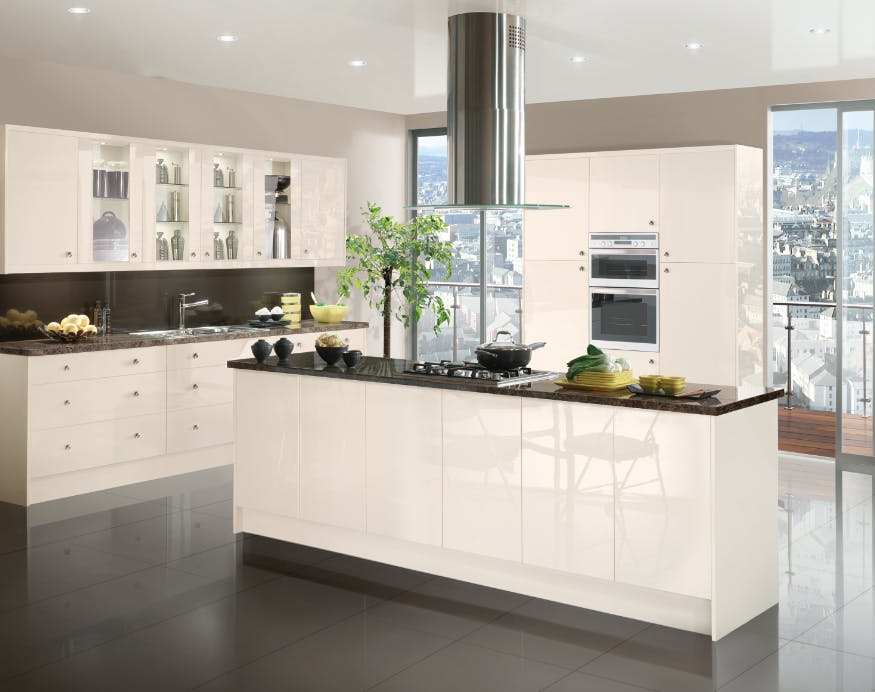
Colour
The island's colour can either blend harmoniously with its surroundings or become a striking focal point. If you want to make a statement and draw attention, consider a bold colour that sets your island apart. This choice adds a dash of personality and serves as an artistic centrepiece.
On the flip side, selecting a neutral colour allows your island to seamlessly merge with the rest of your kitchen, creating a sense of continuity and balance. The colour palette should align with your design goals and personal taste.
If you want your kitchen island to be a focal point, you might choose a bold colour. If you want it to blend in, you might choose a neutral colour.
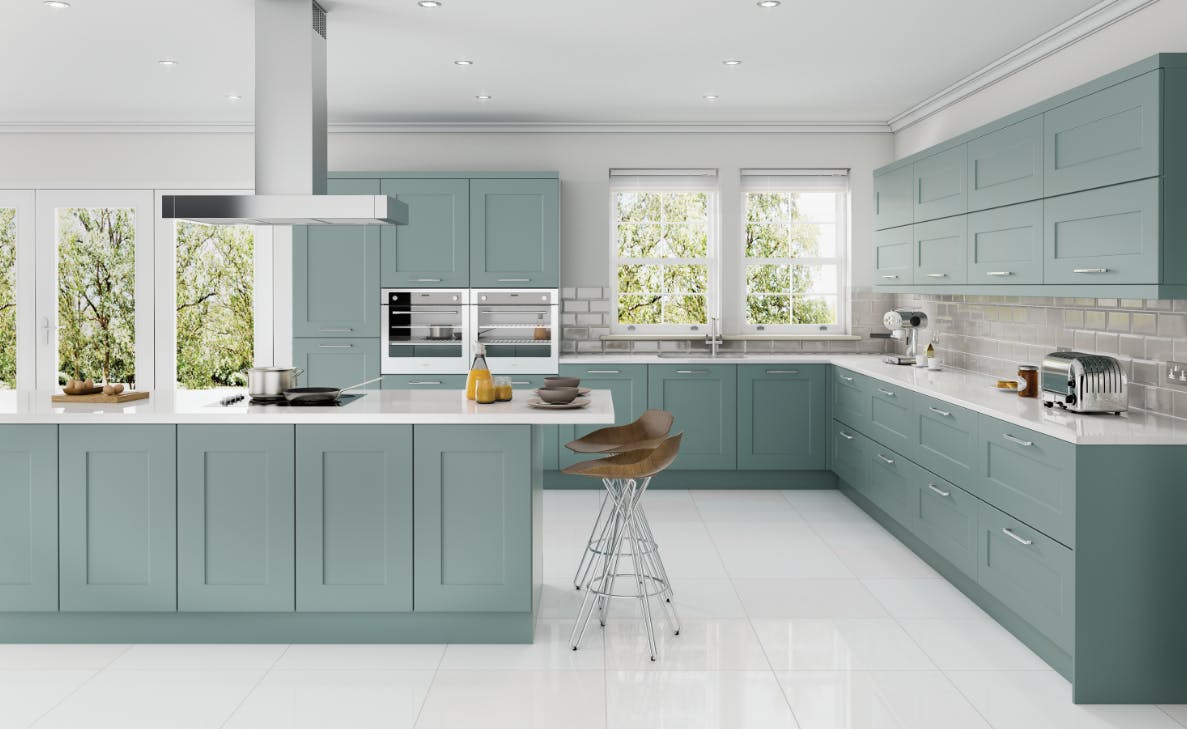
Finishes
The finishes applied to your kitchen island contribute not only to its style but also to its durability:
>Wood finishes introduce warmth and texture, making your island an inviting centrepiece
>Stone finishes, such as granite or quartz, offer both luxury and resilience
>Laminate, with its versatile design options and ease of maintenance, provides practicality
The finish you choose should not only resonate with your design vision but also consider the island's function. For a high-traffic prep area, durability is paramount, guiding you towards robust options like stone or quality laminate.
Accents
Consider hardware choices, such as drawer pulls and cabinet knobs, as the jewellery of your island. These accents reflect your taste, whether it leans towards modern and sleek or classic and ornate.
Lighting plays a dual role, offering both functionality and a design statement. Pendant lights, for instance, serve as both task lighting for your island's workspace and as decorative elements. Their design and quality of illumination can further enhance the island's aesthetic appeal.
Lastly, don't overlook the power of decorative tiles or a distinctive backsplash. These elements introduce patterns, colours, and textures that elevate your island's visual charm, making it an exquisite focal point in your kitchen.
Installing your kitchen island
In bringing your kitchen island vision to life, our fully project-managed service ensures a qualified contractor plays a central role. Their expertise spans structural considerations, electrical, and plumbing requirements, making them invaluable partners throughout your project.
Their skill set ensures that your island is not only aesthetically pleasing but also functional and safe.
As part of our fully project-managed service, ensuring that your qualified contractor follows the manufacturer's instructions is a fundamental aspect of the installation process.
These guidelines are meticulously tailored to the unique design and materials of your island, and strict adherence to them is paramount for maximising longevity and performance. Any deviation from these instructions can potentially result in structural issues, jeopardising the integrity of your island.
Maintenance and care
Once your kitchen island is installed and integrated into your daily life, maintaining its pristine condition is crucial for its longevity and continued enjoyment.
This is why you need to arrange:
>Regular cleaning routines - Regular cleaning is a simple yet effective way to prevent dirt and grime buildup. Depending on the materials used for your island's surface, be it wood, stone, or laminate, use appropriate cleaning agents and methods. Gentle cleansers and non-abrasive tools are generally recommended to avoid surface damage
>Timely repairs - Addressing any damage promptly is essential to preserve the integrity of your kitchen island. Whether it's a scratch, chip, or loose hardware, swift repairs prevent issues from worsening and potentially becoming more costly to fix. A proactive approach to maintenance ensures that your island remains a source of pride in your kitchen for years to come.
FAQs
What are the different features that can be included in a kitchen island?
There are many different features that can be included in a kitchen island, depending on your needs and budget. Some of the most common features include:
>Sink: A sink is a must-have for any kitchen island that will be used for food prep.
>Appliances: Stovetops, ovens, and microwaves can all be included in a kitchen island.
>Storage: Kitchen islands can provide a lot of storage space for pots, pans, dishes, and other kitchen essentials.
>Seating: Kitchen islands can also provide seating for family and guests.
>Bartop:: A bartop can be added to a kitchen island to create a more casual dining area.
>Power outlets: Power outlets are essential for any kitchen island that will be used for appliances.
How much does a kitchen island cost?
The cost of a kitchen island will vary depending on the size, materials, and features you choose. A basic freestanding island can cost as little as £1,000, while a fully-equipped island with a sink, appliances, and seating can cost upwards of £10,000.
How do I choose the right kitchen island for my home?
When choosing a kitchen island, there are a few things you need to consider:
>Your needs How will you be using the island? Will you be using it for food prep, seating, or both?
>Your budget: How much are you willing to spend on an island?
>The size of your kitchen: Make sure the island will fit in your kitchen and leave enough space for people to walk around it.
>The style of your kitchen:: The island should complement the style of your kitchen.
>Your lifestyle: If you have young children, you may want to choose an island with rounded corners to prevent accidents.
In summary, the kitchen island serves as the heart of a home, offering a space for gatherings and culinary creativity. It provides increased workspace, storage, and seating, enhancing the functionality of modern kitchens.
However, its inclusion should be carefully considered, especially in small kitchens or those with limited counter space. Thoughtful planning regarding size, shape, location, and materials is essential. The integration of sinks, appliances, storage, and seating requires expert guidance for seamless functionality. Regular maintenance, including cleaning and timely repairs, ensures the island's longevity and continued enjoyment.
By following these guidelines, your kitchen island can truly become the heart of your culinary sanctuary.
Tips for choosing the right kitchen island for your home
Consider your needs and budget
To kick things off, let's take a good look at what you really need and what your wallet can handle.
Think about what you want this island to do for you. Are you going to use your kitchen island for chopping and cooking up a storm, or maybe it's gonna be the secret storage hideout for your pots and pans? Figure out what you need this space to be in your life.
After establishing your goals, getting a handle on your budget is a big deal too. You want your kitchen island to shine, but you don't want it to drain your wallet. So, let's be practical and make sure your island doesn't break the bank. We're all about keeping things in check and making your island dreams come true without any financial woes.
Choose a style that compliments your kitchen
Your kitchen island should be a harmonious extension of your kitchen's overall style. Whether your kitchen leans toward modern minimalism or traditional elegance, the island should complement this aesthetic. Matching the island's style to that of your kitchen creates a cohesive visual flow that enhances the overall appeal of your culinary space.
Make sure there is enough space for it in your kitchen
Practicality is key when it comes to kitchen islands, and space planning plays a pivotal role. Ensure that your kitchen has sufficient space to accommodate the island comfortably. A well-thought-out layout not only facilitates movement but also enhances the island's functionality. Factors such as traffic flow, clearance, and access to essential kitchen zones (stove, sink, refrigerator) should all be considered to optimise your island's placement. Consulting with a professional kitchen designer can be invaluable in this regard.
Hire a qualified contractor to install it
After you've made your selection, our fully project-managed service empowers you to entrust the installation of your kitchen island to a qualified contractor. Their expertise is paramount in ensuring proper installation, in strict compliance with safety standards and local regulations. Our skilled contractors are well-versed in managing not only the structural aspects but also the intricacies of electrical and plumbing requirements, especially if your island incorporates appliances or a sink. This professional approach guarantees the island's stability and longevity, enhancing its value in your kitchen project.
Share this Post






.jpg?auto=compress%2Cformat&cs=strip&ixlib=php-1.1.0&s=5dd50ad091853180ea8122cfef81c5a1)
.jpg?auto=compress%2Cformat&cs=strip&ixlib=php-1.1.0&s=ac7426beeecf93754405996e88b3eded)
.jpg?auto=compress%2Cformat&cs=strip&ixlib=php-1.1.0&s=a8e0030a6766994d61aa1d69e21c3884)
.jpg?auto=compress%2Cformat&cs=strip&ixlib=php-1.1.0&s=0bf22ff7a62f6e04bb8c7bf5a2658379)
.jpg?auto=compress%2Cformat&cs=strip&ixlib=php-1.1.0&s=6335afe89ee29331f4491ba1e310ba3d)
.jpg?auto=compress%2Cformat&cs=strip&ixlib=php-1.1.0&s=ea1067406123375e42a6da44dda2ffc2)
.jpg?auto=compress%2Cformat&cs=strip&ixlib=php-1.1.0&s=96d9d3cdd039d5f2e47e3e46f8f9e34d)
.PNG?auto=compress%2Cformat&cs=strip&ixlib=php-1.1.0&s=919d17b2c8b8370b67258983ad658d42)
.PNG?auto=compress%2Cformat&cs=strip&ixlib=php-1.1.0&s=3835c8a233c145d46c1fb118a589417f)



